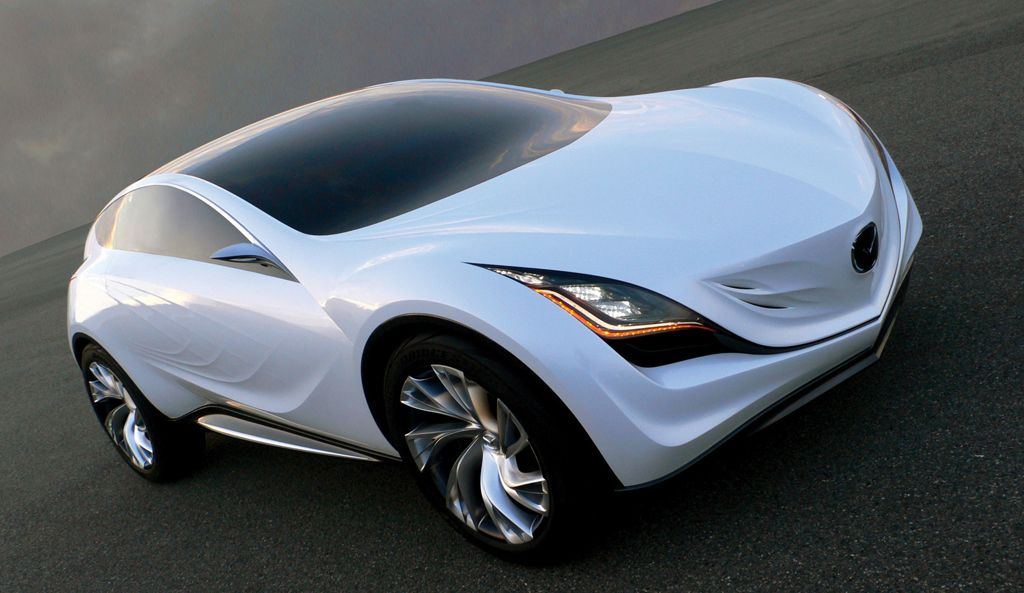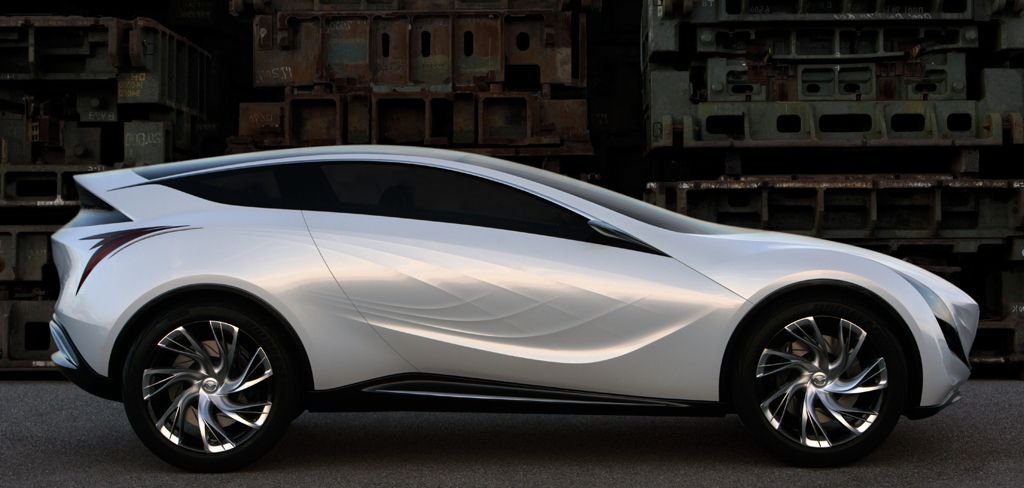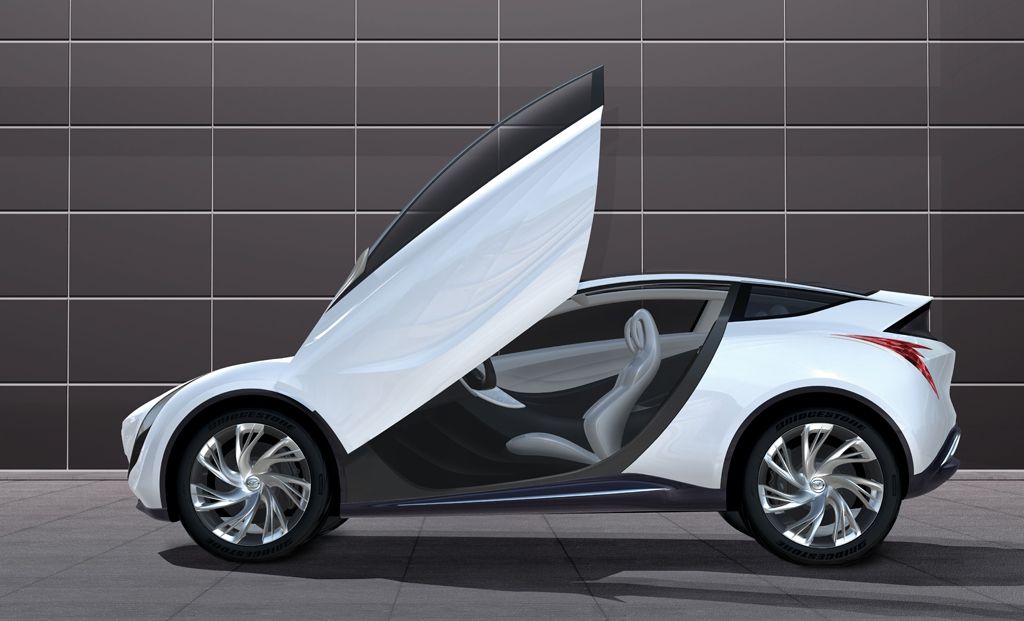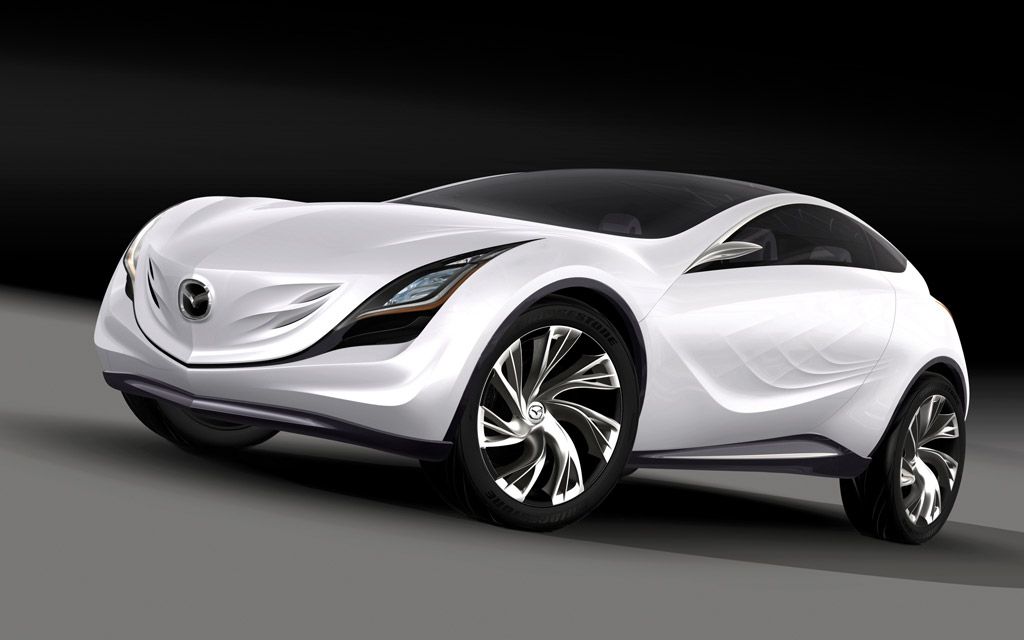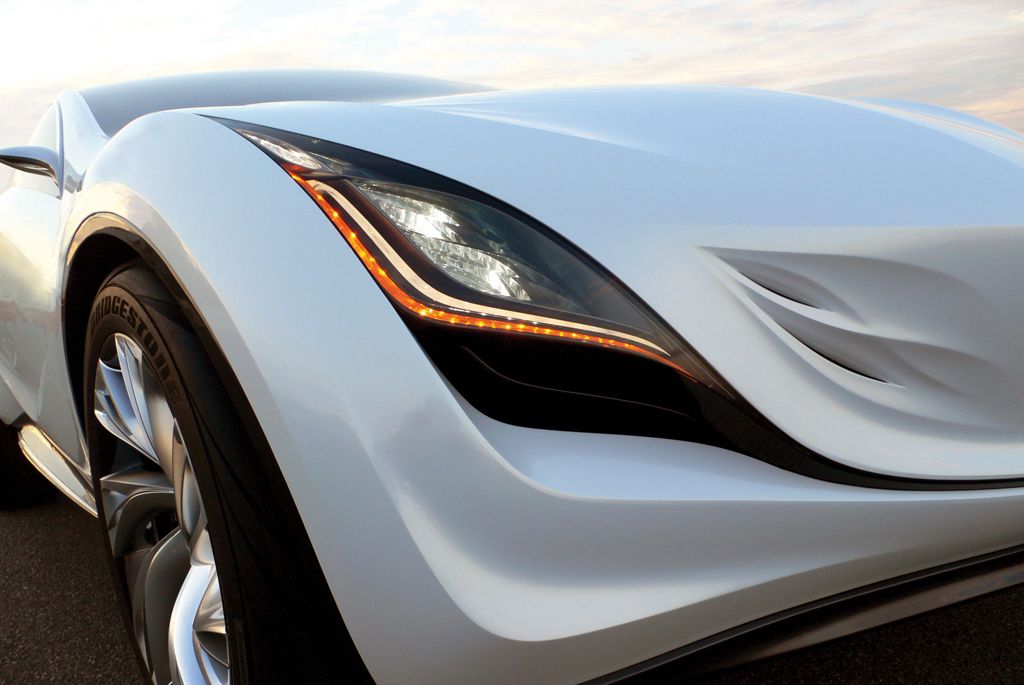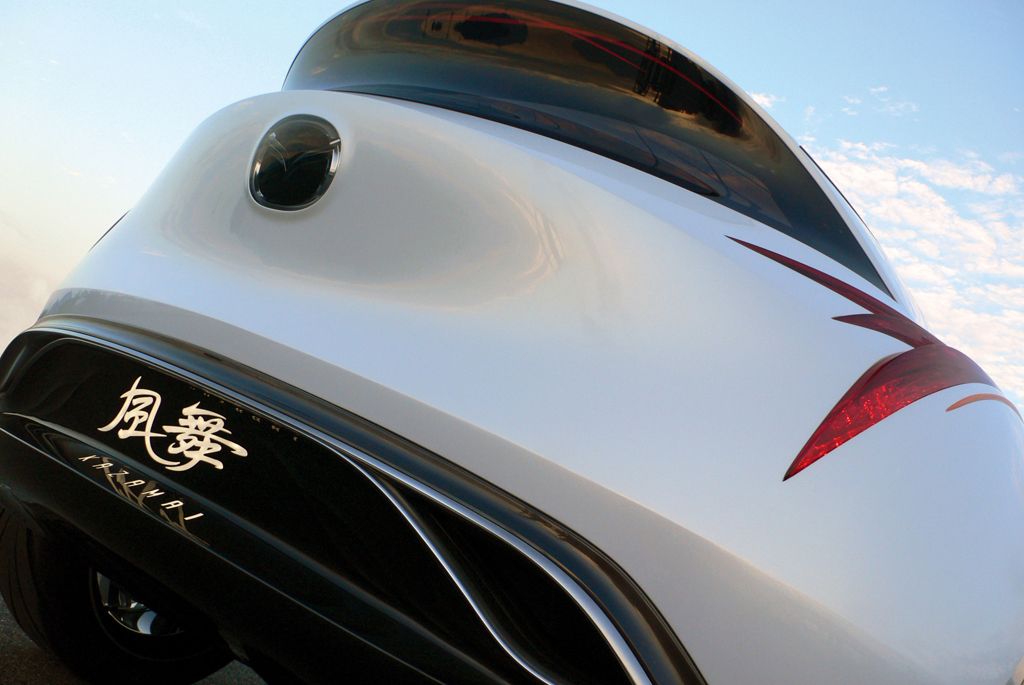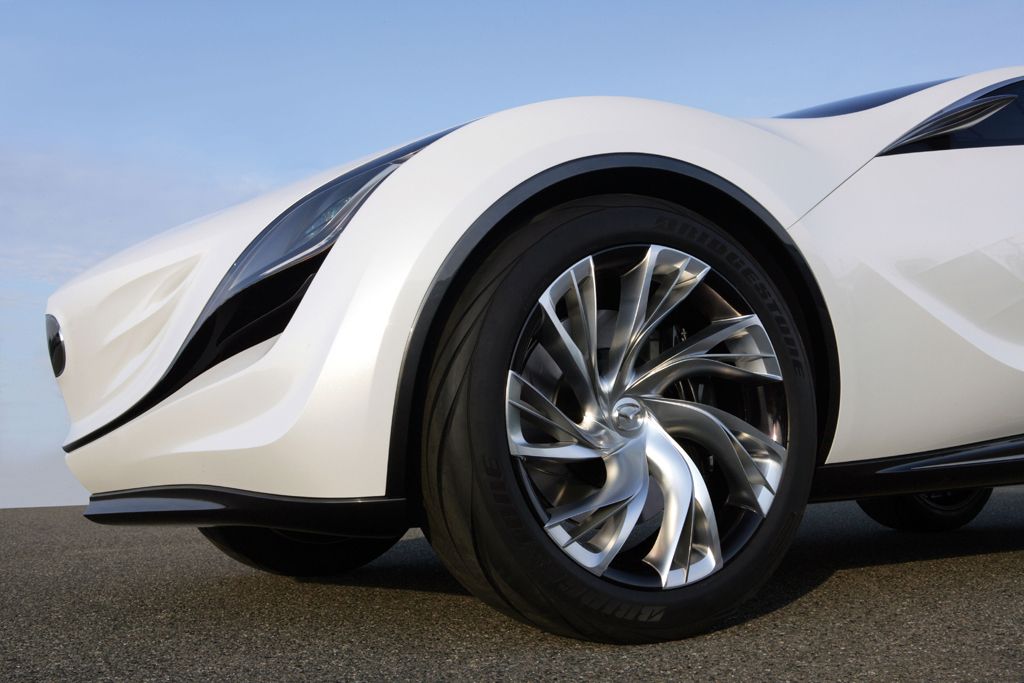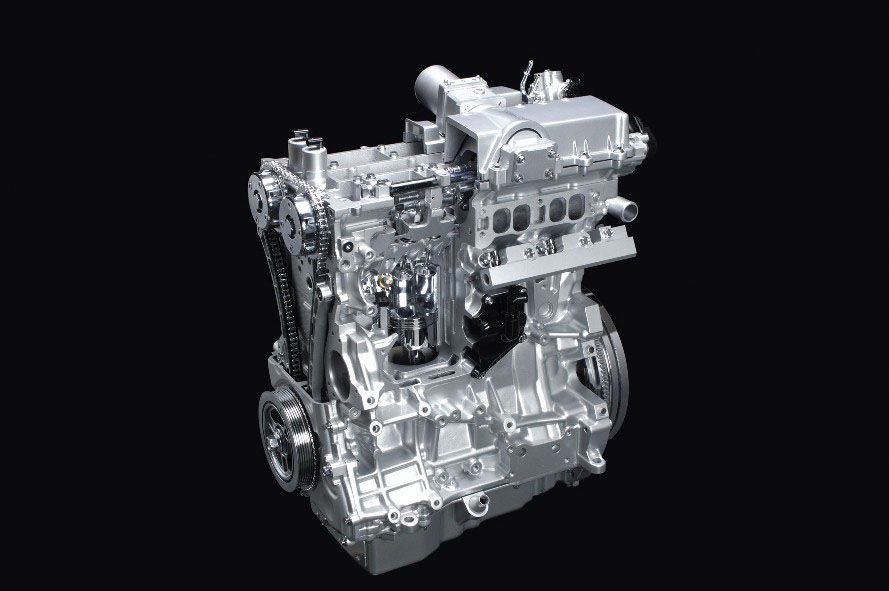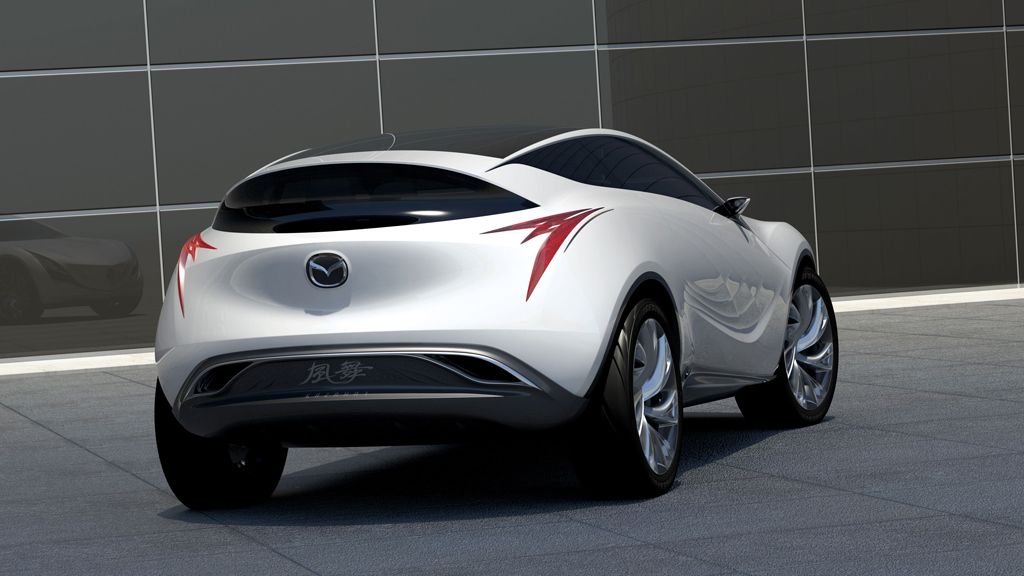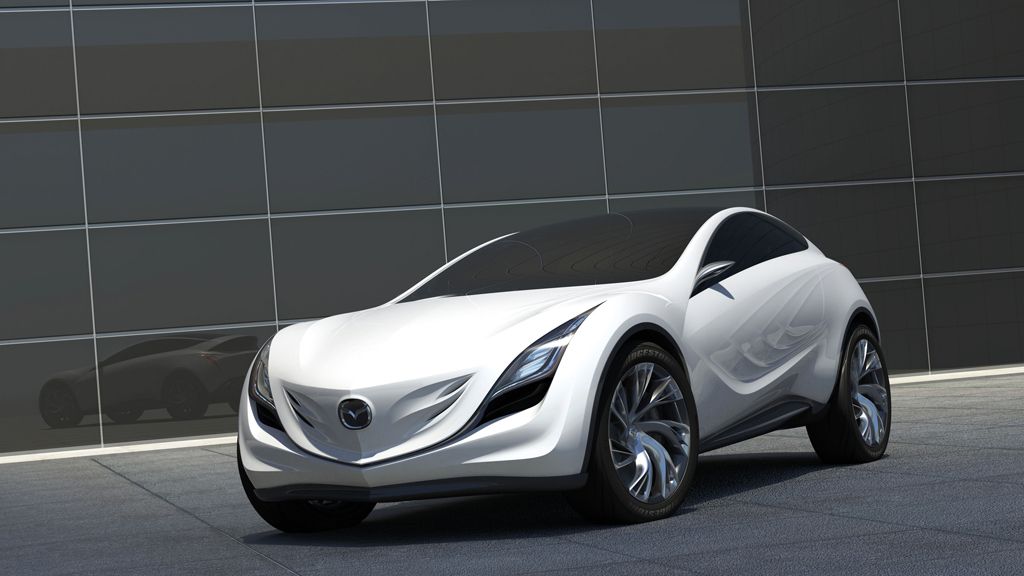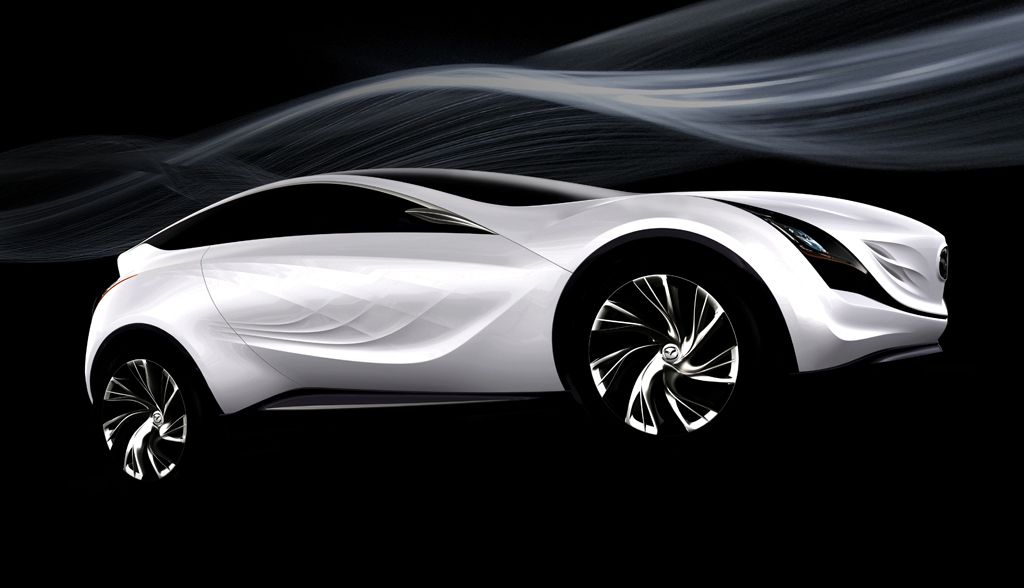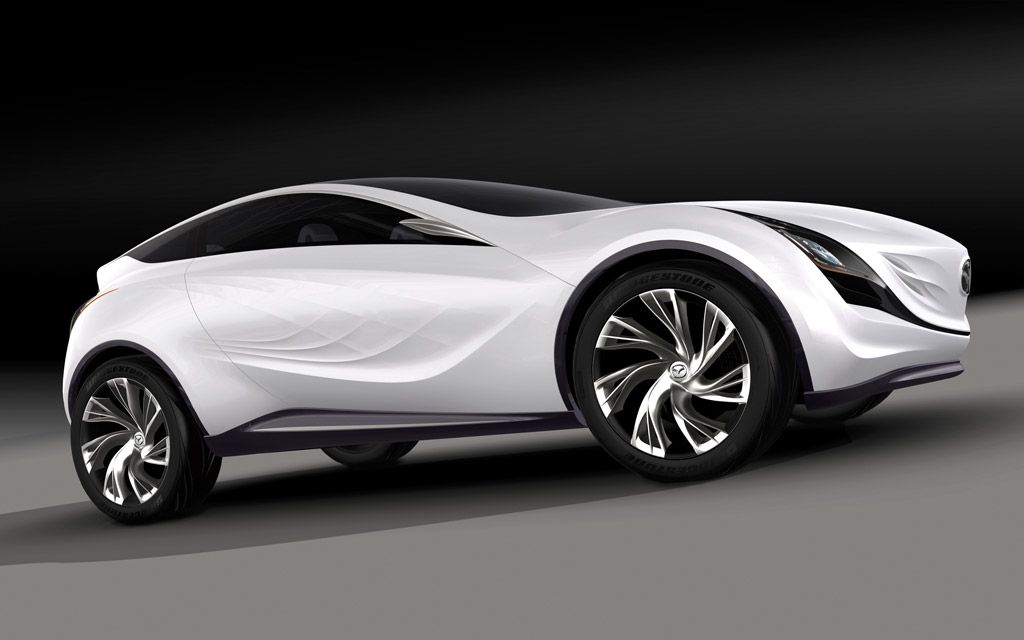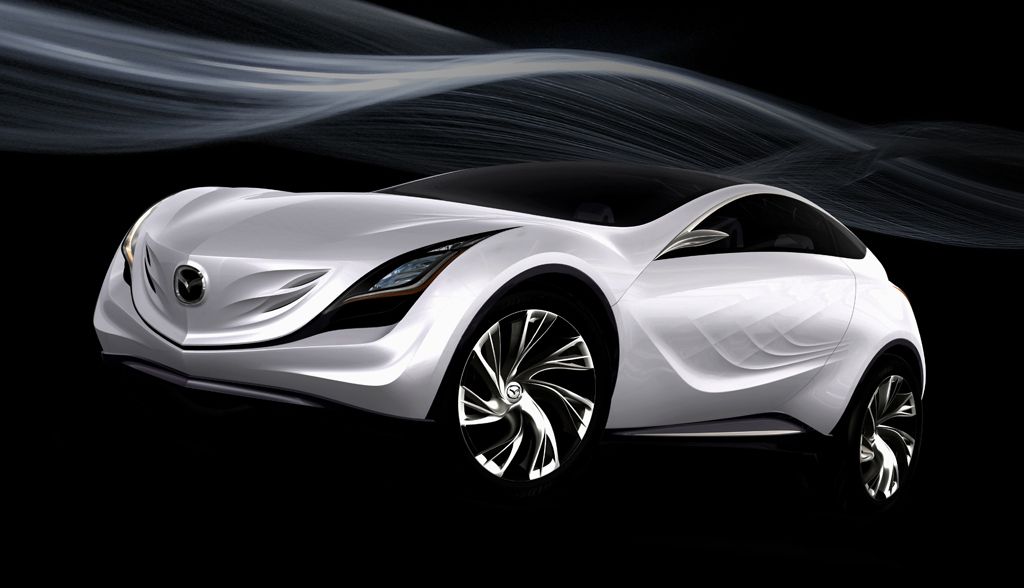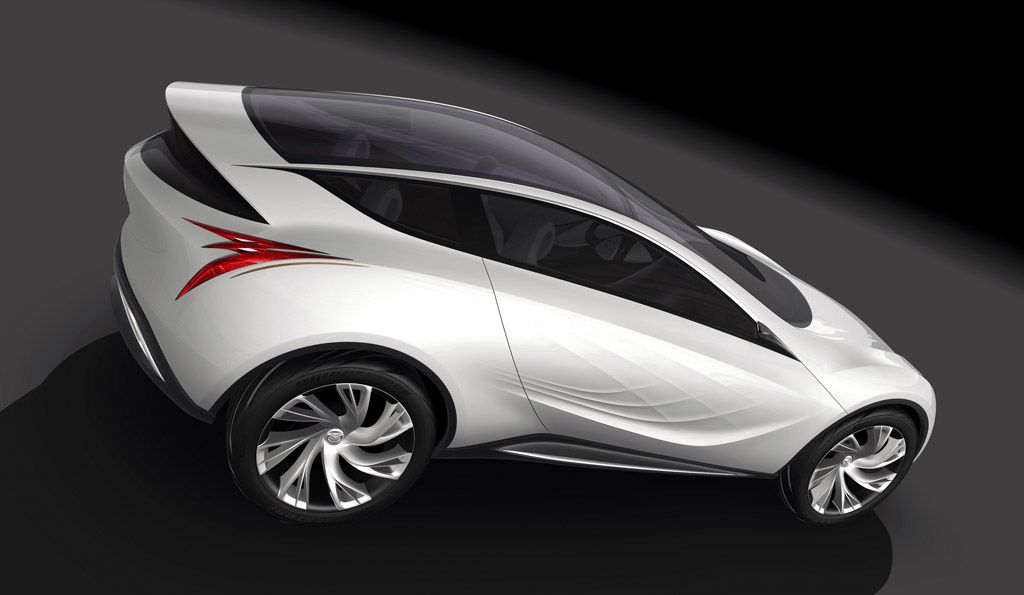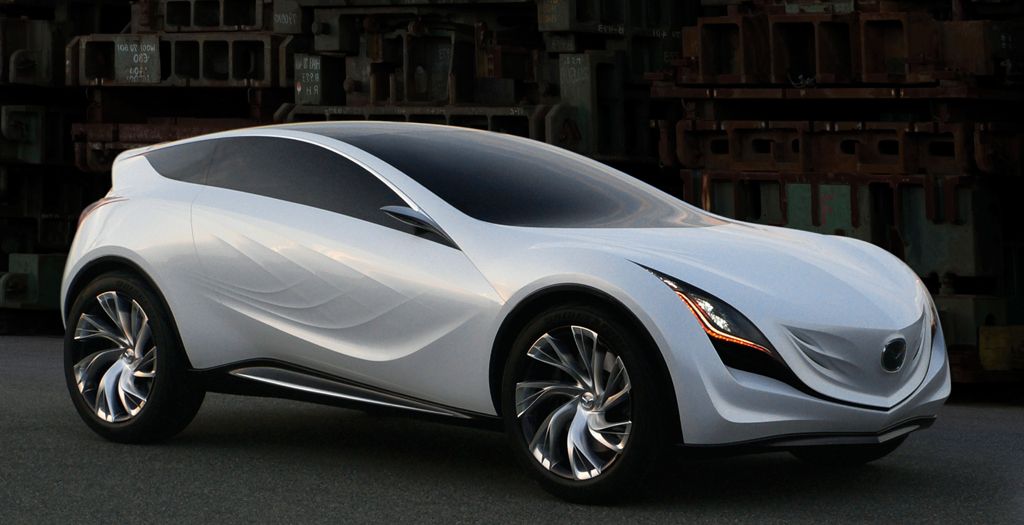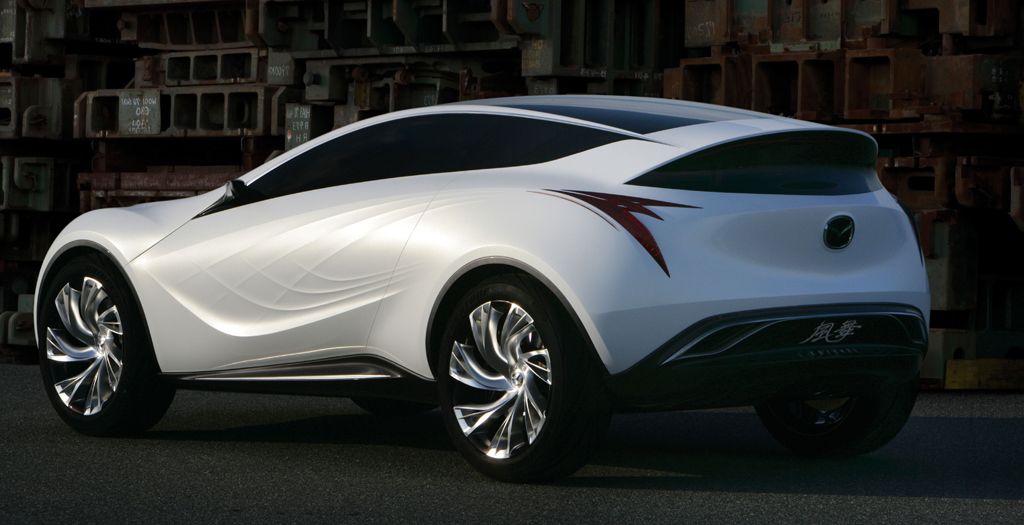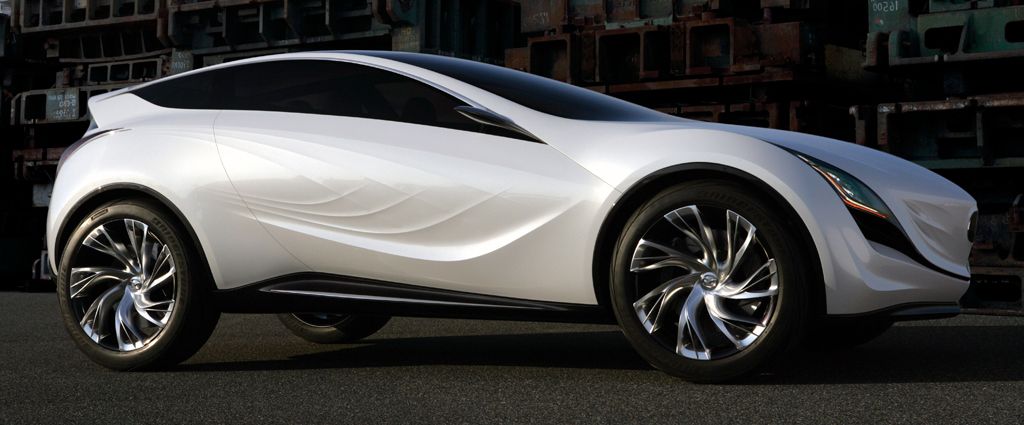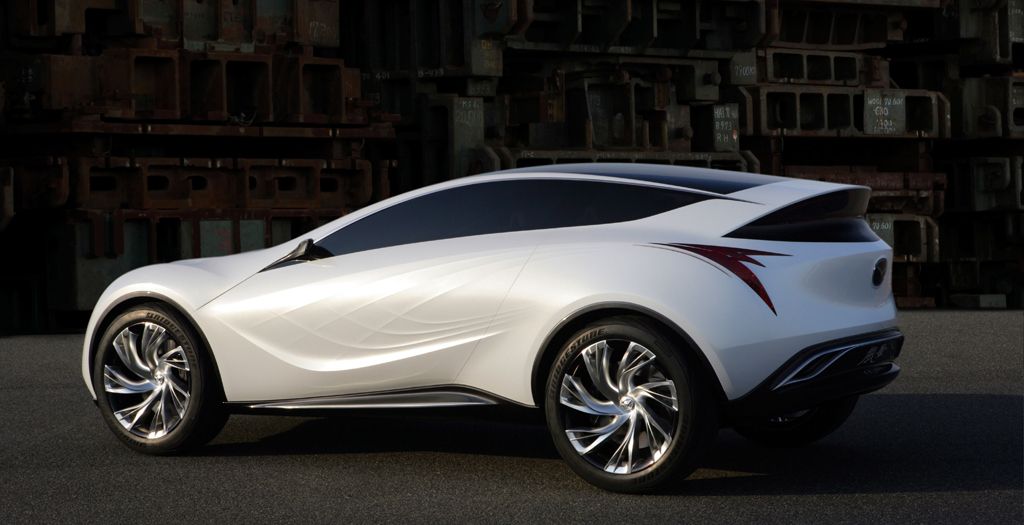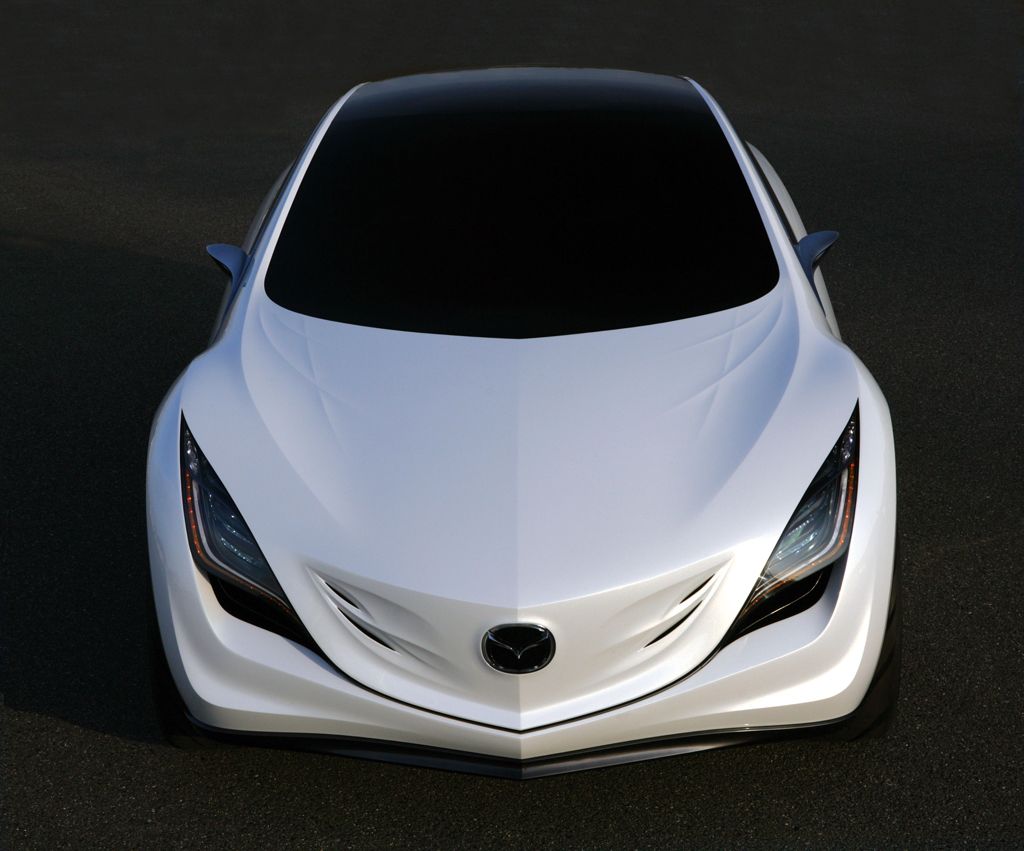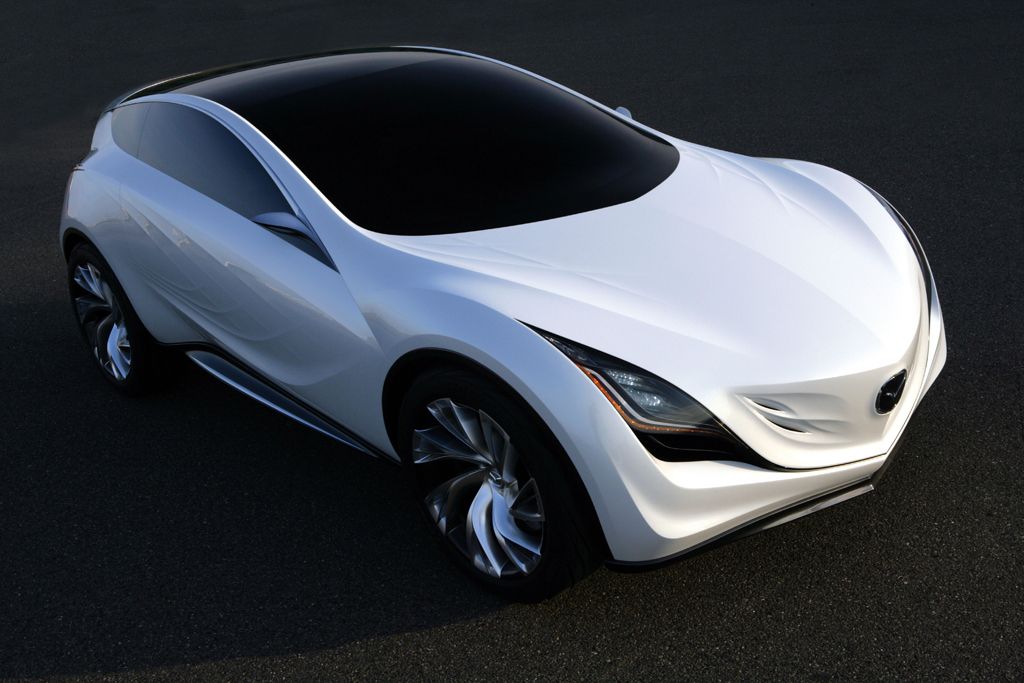Mazda today officially unveiled the Kazamai Concept at the Moscow Motor Show. The concept gives a strong hint at where Mazda might be going with a compact crossover SUV. Small, lightweight with dynamic styling, low-consumption, a next-generation Mazda powertrain, it is meant to appeal to young, upwardly-mobile Russians with a strong sense of style and urban lifestyle demands.
Kazamai means “swirling crosswinds” in Japanese, and was chosen to express the powerful yet nimble character of this crossover. Kazamai is part of the new flowing lines of Mazda concept cars like the Furai.
Mazda Kazamai will feature a DISI engine based on the current Mazda CX-7, with advanced technologies to minimize energy loss and vastly improved thermal efficiency. Mazda’s next generation 2.0-liter DISI engine also has combustion control technology and variable valve control that deliver strong torque throughout the rev-range for good engine response and fuel economy. A next-generation catalyst is used for good emissions performance.
Press release after the jump.
2008 Mazda Kazamai
- Make: Array
- Model: 2008 Mazda Kazamai
- [do not use] Vehicle Model: Array
Press release
Last year, Mazda Motor Corporation announced that it was embarking on a new direction with technology development. The strategy, called ‘Sustainable Zoom-Zoom,’ would focus on producing vehicles that combine Mazda’s trademark driving excitement with further evolved environmental and safety technologies.
‘Sustainable Zoom-Zoom’ and Mazda’s Nagare design have been combined in the Mazda Kazamai concept car which showcases how Mazda could deliver a vehicle in the near future that is exhilarating to look at and exciting to drive, with an improved average fuel economy by 30 percent and producing far fewer emissions than today’s production models. This is Mazda at its best – a cool, athletic compact crossover, with next-generation environmental performance. Designed with the Russian compact SUV segment in mind, Kazamai gives a glimpse at where Mazda is heading with a possible future compact crossover.
Russia’s booming Automobile Market
Between 2004 and the end of 2007, Russia’s automobile market grew by about 1.28 million cars, and in the process became Europe’s second largest car market after Germany. During this same period, Mazda quickly established itself as one of Russia’s most popular car brands, increasing sales from 8,565 units in 2004 to over 50,000 units last year – six times more than 2004.
One of the country’s biggest segments is the sports utility vehicle (SUV), representing 16 percent of the total sales volume in 2007. Between 2004 and 2007, the segment became 10 times larger and this growth is expected to continue over the mid-term in Russia. Mazda’s mid-sized sports crossover SUV, the CX-7, has been on the market for less than a year in Russia and has already found over 7,900 customers – easily Mazda’s largest market for the CX-7 in Europe.
The Mazda Kazamai concept car addresses the growing popularity of SUVs in Russia and gives a strong hint at where Mazda might be going with a compact crossover SUV. Small, lightweight with dynamic styling, low-consumption, a next-generation Mazda powertrain, it is meant to
appeal to young, upwardly-mobile Russians with a strong sense of style and urban lifestyle demands.
Design – Evolved Nagare Design
Mazda Kazamai means “swirling crosswinds” in Japanese, and was chosen to express the powerful yet nimble character of this stylish and compact crossover. Kazamai is dynamic and athletic looking on the outside and displays an evolved Nagare ‘flow’ design. Unlike previous concept cars, Mazda Kazamai’s styling represents powerful natural movements that are emotionally expressed through three-dimensional motifs stretching over the whole body, representing a fusion of design and functionality.
Mazda Kazamai is an impressive combination of packaging requirements and design aesthetics. With a width of 1,930 mm and a length of 4,520 mm, it is slightly larger than the current Mazda3, with room for SUV comfort and functionality on the inside. Yet, because it is only 1,500 mm high, has a flat roofline and very short rear overhangs, it also has a sporty coupe look with the promise of driving fun. The innovative body design features flared fenders that emphasize SUV-like strength and a cabin befitting a sports car. The wedge-shaped profile was designed to evoke the image of a sleek arrow cutting through a mighty wind. In particular, the body design between the front wheel arches and the roof pillars is intended to express the agility and dynamism of wind gusting along the side of the vehicle. The panel lines on the sides represent swift and elegant crosswinds, further accentuating the dynamic and stylish body design. The bonnet itself is lower in the center than on the sides, which emphasizes the car’s powerful front fenders that accommodate large, 22-inch wheels.
The wheel design continues the crosswinds motif with each spoke carefully twisted and larger outside than in the center, providing a strong sense of movement. The five-point grille is integrated into the body to create a clean and light image which, together with the flared front lower sides contributes to excellent aerodynamic characteristics. The aerodynamics are further improved by making the air intakes as small as possible. The side sill panels and rear combination light covers also help to control the wind flow and reduce drag even further.
Interior – SUV Functionality with Driving Safety
Mazda Kazamai is not only a pure expression of speed and power, it also accommodates up to four passengers with compact SUV comfort and functionality. It was designed to fulfil various driver and vehicle interfaces so as to support the driver in enjoying safe and stress-free driving, with well considered human machine interface visibility and operation cockpit. This is one of Mazda’s important areas of the Sustainable Zoom-Zoom plan.
Lightweight and Aerodynamic
Weight reduction and superior aerodynamic performance are core technologies to improve both driving pleasure and environment performance, especially fuel economy. Mazda will further focus on these crucial factors in order to achieve the goals of the Sustainable Zoom-Zoom plan. Despite its powerful exterior look, the Mazda Kazamai concept’s aerodynamic performance is achieved through a flat floor panel, a rear diffuser, and a low roof line. The aim was to make the Kazamai’s aerodynamics more than 10% better than other vehicles in its class.
When Mazda set about reducing the bodyweight, they leveraged CAE applications and focused on four major areas: collision safety, handling, NVH, and strength. At the same time, lightweight materials and new processing/joining technologies were put to effective use. Aluminum or aluminum-alloy is used for the bonnet, chassis and engine block. The designers aimed to make it 100 kilograms lighter than similar models by employing plastics for the panels, fenders and the engine cover. These features also contribute to advanced handling and improved fuel economy and CO2 emissions.
Next-Generation Powertrain – 30 Percent Improvement in Fuel Consumption
The ideal match for the Mazda Kazamai concept would be a next-generation 2.0-litre direct-injection petrol engine, which Mazda engineers are currently developing. This engine delivers a balance of sporty driving – especially in a compact car like the Mazda Kazamai – with good environmental performance. Mazda Kazamai will feature a DISI* engine based on the current Mazda CX-7, with advanced technologies to minimize energy loss and vastly improved thermal efficiency. Mazda’s next generation 2.0-litre DISI petrol engine also has combustion control technology and variable valve control that deliver strong torque throughout the rev-range for excellent engine response as well as superior fuel economy. A next-generation catalyst also ensures superior emissions performance.
*DISI: Direct Injection Spark Ignition
This is coupled to a lightweight and next-generation compact six-speed automatic transmission that is highly responsive and delivers the direct feel of a manual transmission, and four-wheel drive for superior traction. In combination with Kazamai’s next-generation aerodynamics and its lightweight body outlined above, this powertrain would deliver an estimated 30 percent improvement in fuel consumption and emissions (versus the current MZR 2.0-litre petrol) – without compromising driving pleasure.
Advanced Safety and Security Features
Mazda Kazamai is not only lightweight, fuel-efficient and fun to drive, it is also designed with safety as a key element. Its advanced body shell is a product of a new body structure program currently being refined at Mazda with a lightweight structure that provides high levels of crash safety. Mazda Kazamai also has a long list of active safety features including roll stability control, blind spot monitoring to assist lane change, a pre-crash safety system and advanced dynamic stability control (DSC) to support the driver. And to meet future pedestrian safety requirements, it has soft plastic fenders and a shock-cone aluminum bonnet that is very efficient in absorbing impact energy.
Also onboard the Mazda Kazamai is a personal security system. This advanced system monitors the area around and inside the car, and has an automatic alert system which informs the driver in the event of an emergency to help to protect both the owner and occupants.
Technical Specifications – Mazda Kazamai Concept Car
Dimensions Overall length 4,520 mm
Overall width 1,930 mm
Overall height 1,500 mm
Wheelbase 2,780 mm
Seating capacity 4 people
Engine Type Next-generation 2.0L DISI petrol
Transmission Type Next-generation 6AT
Suspension Type Front: McPherson Strut,
Rear: Multi-link
Tire Type 265/45 R22 Bridgestone

